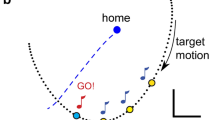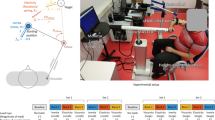Abstract
An important window into sensorimotor function is how humans interact and stop moving projectiles, such as stopping a door from closing shut or catching a ball. Previous studies have suggested that humans time the initiation and modulate the amplitude of their muscle activity based on the momentum of the approaching object. However, real-world experiments are constrained by laws of mechanics, which cannot be manipulated experimentally to probe the mechanisms of sensorimotor control and learning. An augmented-reality variant of such tasks allows for experimental manipulation of the relationship between motion and force to obtain novel insights into how the nervous system prepares motor responses to interact with moving stimuli. Existing paradigms for studying interactions with moving projectiles use massless objects and are primarily focused on quantifying gaze and hand kinematics. Here, we developed a novel collision paradigm using a robotic manipulandum where participants mechanically stopped a virtual object moving in the horizontal plane. On each block of trials, we varied the virtual object’s momentum by increasing either its velocity or mass. Participants stopped the object by applying a force impulse that matched the object momentum. We observed that hand force increased as a function of object momentum linked to changes in virtual mass or velocity, similar to results from studies involving catching free-falling objects. In addition, increasing object velocity resulted in later onset of hand force relative to the impending time-to-contact. These findings show that the present paradigm can be used to determine how humans process projectile motion for hand motor control.





Similar content being viewed by others
Data availability
The datasets generated during and/or analyzed during the current study are available from the corresponding author on reasonable request.
References
Barany DA, Gómez-Granados A, Schrayer M, Cutts SA, Singh T (2020) Perceptual decisions about object shape bias visuomotor coordination during rapid interception movements. J Neurophysiol 123:2235–2248. https://doi.org/10.1152/jn.00098.2020
Bennett SJ, Xivry J-J, Barnes GR, Lefèvre P (2007) Target Acceleration can be extracted and represented within the predictive drive to ocular pursuit. J Neurophysiol 98:1405–1414. https://doi.org/10.1152/jn.00132.2007
Bowman MC, Johannson RS, Flanagan JR (2009) Eye–hand coordination in a sequential target contact task. Exp Brain Res 195:273–283. https://doi.org/10.1007/s00221-009-1781-x
Brenner E, Smeets JB (2011) Continuous visual control of interception. Hum Mov Sci 30:475–494
Brenner E, Rodriguez IA, Munoz VE et al (2016) How can people be so good at intercepting accelerating objects if they are so poor at visually judging acceleration? i-Perception 7:2041669515624317
Brouwer A-M, Brenner E, Smeets JB (2002) Perception of acceleration with short presentation times: can acceleration be used in interception? Percept Psychophys 64:1160–1168
Burdet E, Franklin DW, Milner TE (2013) Human robotics: neuromechanics and motor control. The MIT Press, Cambridge
Burkholder TJ (2016) Model-based approaches to understanding musculoskeletal filtering of neural signals. In: Prilutsky BI, Edwards DH (eds) Neuromechanical modeling of posture and locomotion. Springer, New York, pp 103–120
Debats NB, Kingma I, Beek PJ, Smeets JB (2012) Moving the Weber fraction: the perceptual precision for moment of inertia increases with exploration force. PLoS ONE 7:e42941
Heath M, Westwood DA, Binsted G (2004) The control of memory-guided reaching movements in peripersonal space. Mot Control 8:76–106
Jones LA (1986) Perception of force and weight: theory and research. Psychol Bull 100:29–42
Kreyenmeier P, Kämmer L, Fooken J, Spering M (2022) Humans can track but fail to predict accelerating objects. eNeuro 9:ENEURO.0185-0122.2022. https://doi.org/10.1523/eneuro.0185-22.2022
Kuling IA, Salmen F, Lefèvre P (2019) Grip force preparation for collisions. Exp Brain Res 237:2585–2594. https://doi.org/10.1007/s00221-019-05606-y
Kurtzer IL (2015) Long-latency reflexes account for limb biomechanics through several supraspinal pathways. Front Integr Neurosci 8:99
Lacquaniti F, Maioli C (1989a) Adaptation to suppression of visual information during catching. J Neurosci 9:149–159. https://doi.org/10.1523/jneurosci.09-01-00149.1989
Lacquaniti F, Maioli C (1989b) The role of preparation in tuning anticipatory and reflex responses during catching. J Neurosci 9:134–148. https://doi.org/10.1523/jneurosci.09-01-00134.1989
Lacquaniti F, Borghese N, Carrozzo M (1991) Transient reversal of the stretch reflex in human arm muscles. J Neurophysiol 66:939–954
Lacquaniti F, Borghese N, Carrozzo M (1992) Internal models of limb geometry in the control of hand compliance. J Neurosci 12:1750–1762
Lacquaniti F, Carrozzo M, Borghese NA (1993) Time-varying mechanical behavior of multijointed arm in man. J Neurophysiol 69:1443–1464
Lee DN (1976) A theory of visual control of braking based on information about time-to-collision. Perception 5:437–459
Lee DN (1998) Guiding movement by coupling taus. Ecol Psychol 10:221–250
Lisberger SG, Morris EJ, Tychsen L (1987) Visual motion processing and sensory-motor integration for smooth pursuit eye movements. Annu Rev Neurosci 10:97–129
McIntyre J, Zago M, Berthoz A, Lacquaniti F (2001) Does the brain model Newton’s laws? Nat Neurosci 4:693–694
McKee SP (1981) A local mechanism for differential velocity detection. Vision Res 21:491–500
Merfeld DM, Zupan L, Peterka RJ (1999) Humans use internal models to estimate gravity and linear acceleration. Nature 398:615–618
Mrotek LA, Soechting JF (2007) Target interception: hand–eye coordination and strategies. J Neurosci 27:7297–7309
Port NL, Lee D, Dassonville P, Georgopoulos AP (1997) Manual interception of moving targets I. Performance and movement initiation. Exp Brain Res 116:406–420. https://doi.org/10.1007/pl00005769
Price NS, Ono S, Mustari MJ, Ibbotson MR (2005) Comparing acceleration and speed tuning in macaque MT: physiology and modeling. J Neurophysiol 94:3451–3464
Scott SH (2012) The computational and neural basis of voluntary motor control and planning. Trends Cogn Sci 16:541–549
Senot P, Zago M, Le Séac’h A, Zaoui M, Berthoz A, Lacquaniti F, McIntyre J (2012) When up is down in 0g: how gravity sensing affects the timing of interceptive actions. J Neurosci 32:1969–1973
Singh T, Fridriksson J, Perry CM, Tryon SC, Ross A, Fritz SL, Herter TM (2017) A novel computational model to probe visual search deficits during motor performance. J Neurophysiol 117:79–92. https://doi.org/10.1152/jn.00561.2016
Spering M, Montagnini A (2011) Do we track what we see? Common versus independent processing for motion perception and smooth pursuit eye movements: a review. Vis Res 51:836–852
Tresilian JR (1991) Empirical and theoretical issues in the perception of time to contact. J Exp Psychol Hum Percept Perform 17:865
Tresilian JR (1999) Visually timed action: time-out for ‘tau’? Trends Cogn Sci 3:301–310
Tresilian JR (2005) Hitting a moving target: perception and action in the timing of rapid interceptions. Percept Psychophys 67:129–149
Trewhella J, Edwards M, Ibbotson MR (2003) Sensitivity to the acceleration of looming stimuli. Clin Exp Ophthalmol 31:258–261
White O, Thonnard J-L, Wing A, Bracewell R, Diedrichsen J, Lefevre P (2011) Grip force regulates hand impedance to optimize object stability in high impact loads. Neuroscience 189:269–276
Zago M, Lacquaniti F (2005) Cognitive, perceptual and action-oriented representations of falling objects. Neuropsychologia 43:178–188
Funding
AGG received partial support from the Universidad de Costa Rica. A portion of this work was supported by a grant from the University of Georgia Research Foundation, Inc. to TS.
Author information
Authors and Affiliations
Contributions
AGG and TS conceived and designed research; AGG and SG performed experiments; AGG, DAB, and TS analyzed data; AGG, DAB, IK and TS interpreted results of experiments; AGG and TS prepared figures; TS, AG, IK, DAB drafted manuscript; AGG, IK, DAB, and TS edited and revised manuscript; AGG, IK, SG, DAB, and TS approved the final version of manuscript.
Corresponding author
Ethics declarations
Conflict of interest
On behalf of all authors, the corresponding author states that there is no conflict of interest.
Additional information
Communicated by Francesco Lacquaniti.
Publisher's Note
Springer Nature remains neutral with regard to jurisdictional claims in published maps and institutional affiliations.
Rights and permissions
Springer Nature or its licensor (e.g. a society or other partner) holds exclusive rights to this article under a publishing agreement with the author(s) or other rightsholder(s); author self-archiving of the accepted manuscript version of this article is solely governed by the terms of such publishing agreement and applicable law.
About this article
Cite this article
Gómez-Granados, A., Kurtzer, I., Gordon, S. et al. Object motion influences feedforward motor responses during mechanical stopping of virtual projectiles: a preliminary study. Exp Brain Res 241, 1077–1087 (2023). https://doi.org/10.1007/s00221-023-06576-y
Received:
Accepted:
Published:
Issue Date:
DOI: https://doi.org/10.1007/s00221-023-06576-y




